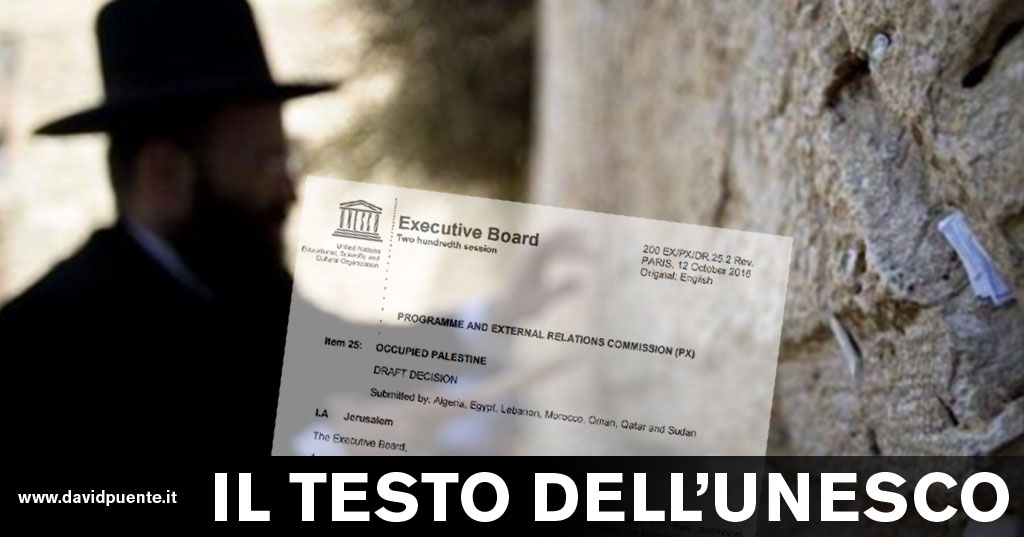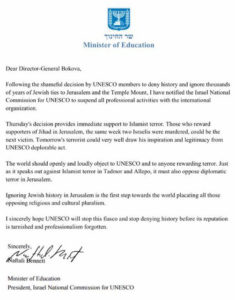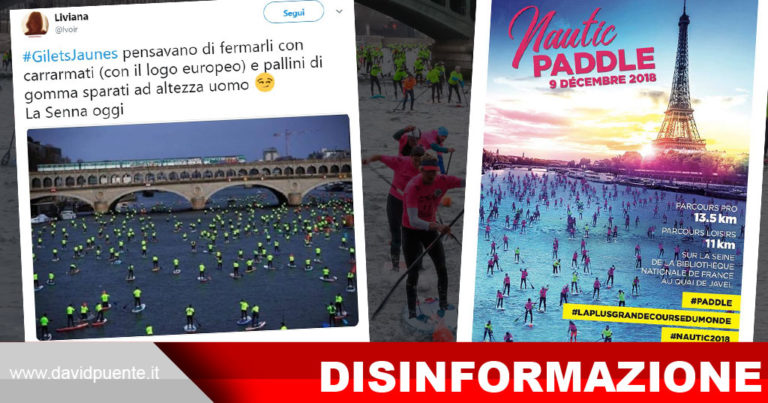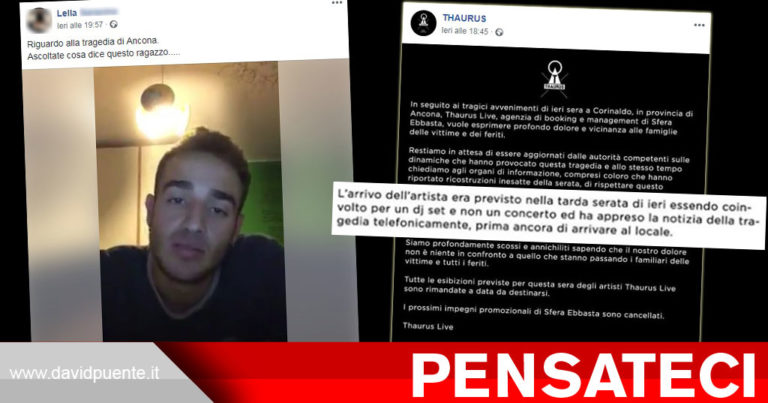Mi segnalano un articolo pubblicato da Il Foglio il 13 ottobre 2016 dal titolo “L’Unesco riscrive la storia: il Monte del Tempio e il Muro del pianto non sono luoghi legati all’ebraismo“:
Una risoluzione del comitato esecutivo ha sancito che questi due luoghi sono sacri soltanto per la religione musulmana, approvando l’utilizzo del solo nome arabo
L’Unesco – l’organizzazione delle Nazioni Unite per l’educazione, la scienza e la cultura – ha deciso che il Monte del Tempio e il Muro del Pianto non hanno nulla a che fare con l’ebraismo. Una risoluzione del comitato esecutivo ha infatti sancito che questi due luoghi sono sacri soltanto per la religione musulmana, approvando l’utilizzo del solo nome arabo, nonostante il riconoscimento “dell’importanza della città vecchia di Gerusalemme e delle sue mura per le tre religioni monoteiste”.
Si tratta di una bozza di risoluzione, che dovrà essere approvata settimana prossima e si dubita che verrà cambiata.
Cosa dice il testo della bozza di risoluzione
Il testo della bozza di risoluzione del 12 ottobre è scaricabile in formato PDF dal sito dell’Unesco (scaricabile anche dal mio sito), permettendoci di leggerne il contenuto e fare da soli le dovute valutazioni.
Leggendo l’intero documento (che riporto per intero nella pagina successiva del mio articolo), vengono riportate molte critiche nei confronti dell’operato israeliano sui luoghi di culto, dove si chiede di rispettare le precedenti decisioni dell’Unesco. Tuttavia, da nessuna parte della bozza di risoluzione si menziona che i luoghi sacri siano soltanto per la religione musulmana, così come non si sostiene che i luoghi non abbiano nulla a che fare con l’ebraismo.
Ecco quanto riportato nei punti 19 e 20 del documento in merito al Monte del Tempio e il Muro del Pianto:
19. Deprecates the continuing Israeli unilateral measures and decisions regarding the Ascent to the Mughrabi Gate, including the latest works conducted at the Mughrabi Gate entrance in February 2015, the instalment of an umbrella at that entrance as well as the enforced creation of a new Jewish prayer platform south of the Mughrabi Ascent in Al-Buraq Plaza “Western Wall Plaza”, and the removal of the Islamic remains at the site, and reaffirms that no Israeli unilateral measures, shall be taken in conformity with its status and obligations under the 1954 Hague Convention for the Protection of Cultural Property in the Event of Armed Conflict;
20. Also expresses its deep concern regarding the illegal demolitions of Umayyad, Ottoman and Mamluk remains as well as other intrusive works and excavations in and around the Mughrabi Gate Pathway, and also requests Israel, the occupying Power, to halt such demolitions, excavations and works and to abide by its obligations under the provisions of the UNESCO conventions mentioned in paragraph 2 above;
In sostanza:
19. Disapprova le continue misure e le decisioni unilaterali di Israele in merito alla salita alla Porta Mughrabi, come le opere più recenti realizzate all’entrata della Porta Mughrabi nel febbraio del 2015, l’installazione di una tenda all’ingresso e la creazione forzata di un nuovo luogo di preghiera ebraica a sud della salita alla Porta Mughrabi nella piazza del Muro Occidentale, e la rimozione delle vestigia islamiche dal sito, e riafferma che Israele non adotterà alcuna misura unilaterale in conformità con il suo status e obblighi ai sensi della Convenzione dell’AIA del 1954 per la protezione dei beni culturali in caso di conflitto armato;
20. Esprime la sua profonda preoccupazione anche in merito alle demolizioni illegali delle vestigia omayyadi, ottomanne e mamelucchi, così come le altre opere e scavi dentro e intorno alla Porta Mughrabi, e chiede anche a Israele, la potenza occupante, di fermare le demolizioni, scavi e opere e che rispetti i suoi obblighi derivanti dalle disposizioni e dalle convenzioni Unesco di cui al precedente paragrafo 2;
Viene, in diverse occasioni, ribadita la considerazione che tali luoghi facciano parte delle tre religioni monoteiste. Ecco quanto riportato nei punti 3 e 36 della bozza di risoluzione:
3. Affirming the importance of the Old City of Jerusalem and its Walls for the three monotheistic religions, also affirming that nothing in the current decision, which aims, inter alia, at the safeguarding of the cultural heritage of Palestine and the distinctive character of East Jerusalem, shall in any way affect the relevant Security Council and United Nations resolutions and decisions on the legal status of Palestine and Jerusalem,
36. Shares the conviction affirmed by the international community that the two sites are of religious significance for Judaism, Christianity and Islam;
Tradotto:
3. Affermando l’importanza della città vecchia di Gerusalemme e le sue mura per le tre religioni monoteiste e affermando che nessun elemento della presente decisione, che ha lo scopo, tra l’altro, di salvaguardare il patrimonio culturale della Palestina e il carattere distintivo di Gerusalemme Est, riguarderà in alcun modo le precedenti risoluzioni e decisioni del Consiglio di Sicurezza delle Nazioni Unite sullo status giuridico della Palestina e di Gerusalemme.
36. Condivide con affermata convinzione per la comunità internazionale che i due siti detengono importanza religiosa per l’Ebraismo, il Cristianesimo e l’Islam;
Le critiche sui nomi usati
Come riporta il The Guardian il 14 ottobre, a far scalpore è l’uso dei nomi usati per definire i luoghi di culto a Gerusalemme:
Netanyahu called draft resolution that uses Islamic names for Muslim and Jewish holy sites ‘absurd’, as Israelis saw language as latest example of UN ‘bias’
[…]
The draft resolution, seen by the Associated Press, diminished the links of two important holy sites in Jerusalem’s Old City to Judaism. The text refers to the site known by Muslims as the Noble Sanctuary and by Jews as the Temple Mount only by its Muslim name. The draft resolution refers to the Muslim site of Al-Buraq Plaza without quotations, but puts the site’s Jewish name, the Western Wall Plaza, in inverted commas.
È vero che il nome in lingua araba non viene virgolettato, al contrario di Western Wall Plaza, così come nei titoli della bozza di risoluzione vengono riportati i nomi arabi:
A PAGINA 2
I.B Al-Aqṣa Mosque/Al-Ḥaram Al-Sharif and its surroundings
I.B.1 Al-Aqṣa Mosque/Al-Ḥaram Al-Sharif
A PAGINA 3
I.B.2 The Ascent to the Mughrabi Gate in Al-Aqṣa Mosque/Al-Ḥaram ash-Sharif
Dobbiamo, però, comprendere chi siano stati i promotori della risoluzione, ossia Algeria, Egitto, Libano, Morocco, Oman, Qatar e il Sudan, che ovviamente li vanno a chiamare con i nomi arabi. Non è una giustificazione, la responsabilità è loro che hanno usato solo i nomi facente parte la loro cultura.
La risposta dell’Unesco è arrivata da parte della sua direttrice, Irina Bokova, riportata sia nell’articolo del The Guardian e nel capitolo successivo riportato qui sotto.
Il botta e risposta tra Israele e Unesco
Il Ministro dell’Educazione israeliano, Naftali Bennet, ha sospeso le attività con l’Unesco attraverso un documento inviato alla direttrice dell’Unesco, Irina Bokova, dove parla anche di “supporto al terrorismo islamico”. Ecco il testo pubblicato il 14 ottobre nella sua pagina Facebook:
Following the shameful decision by Unesco members to deny history and ignore thousands of years of Jewish ties to Jerusalem and the Temple Mount, I have notified the Israel National Commission for Unesco to suspend all professional activities with the international organization.
Thursday’s decision provides immediate support to Islamic terror. Those who reward supporters of Jihad in Jerusalem, the same week two Israelis were murdered, could be the next victim. Tommorw’s terrorist could very well draw his inspiration and legitimacy from Unesco deplorable act.
The world should openly and loudly object to Unesco and to anyone rewarding terror. Just as it speaks out against Islamist terror in Tadmor and Aleppo, it must also oppose diplomatic terror in Jerusalem.
Ignoring Jewish history in Jerusalem in the first step towards the world placating all those opposing religious and cultural pluralism.
I sincerely hope Unesco will stop this fiasco and stop denying history before its reputation is tarnished and professionalism forgotten.
Il 14 ottobre il sito dell’Unesco pubblica le dichiarazioni di Irina Bokova legato al contenuto della bozza di risoluzione:
Paris, 14 October—“As I have stated on many occasions, and most recently during the 40th session of the World Heritage Committee, Jerusalem is the sacred city of the three monotheistic religions – Judaism, Christianity and Islam. It is in recognition of this exceptional diversity, and this cultural and religious coexistence, that it was inscribed on the UNESCO World Heritage list.
“The heritage of Jerusalem is indivisible, and each of its communities has a right to the explicit recognition of their history and relationship with the city. To deny, conceal or erase any of the Jewish, Christian or Muslim traditions undermines the integrity of the site, and runs counter to the reasons that justified its inscription on the UNESCO World Heritage list.“Nowhere more than in Jerusalem do Jewish, Christian and Muslim heritage and traditions share space and interweave to the point that they support each other. These cultural and spiritual traditions build on texts and references, known by all, that are an intrinsic part of the identities and history of peoples. In the Torah, Jerusalem is the capital of King David, where Solomon built the Temple and placed the Ark of the Covenant. In the Bible, Jerusalem is the city of the passion and resurrection of Jesus Christ. In the Quran, Jerusalem is the third holiest site in Islam, where Muhammad arrived after his night journey from Al Haram Mosq (Mecca) to Al Aqsa.
“In this microcosm of humanity’s spiritual diversity, different peoples worship the same places, sometimes under different names. The recognition, use of and respect for these names is paramount. The Al Aqsa Mosque / Al-Haram al-Sharif, the sacred shrine of Muslims, is also the Har HaBayit – or Temple Mount – whose Western Wall is the holiest place in Judaism, a few steps away from the Saint Sepulcher and the Mount of Olives revered by Christians.
“The outstanding universal value of the City, and the reason why it was inscribed on the UNESCO World Heritage list, lies in this synthesis, which is an appeal for dialogue, not confrontation. We have a collective responsibility to strengthen this cultural and religious coexistence, by the power of acts and also by the power of words. This requirement is stronger than ever, to bridge the divisions that harm the multi-faith character of the Old City.
“When these divisions carry over into UNESCO, an Organization dedicated to dialogue and peace, they prevent us from carrying out our mission. UNESCO’s responsibility is to foster this spirit of tolerance and respect for history, and this is my absolute daily determination as Director-General, with all Member States. I am committed to this under all circumstances, because this is our raison d’être — to recall that we are one single humanity and that tolerance is the only way forward in a world of diversity.”
Per Irina Bokova, Gerusalemme è la città sacra delle tre religioni monoteiste (ebraica, cristiana e musulmana), riconosciuto dall’Unesco come luogo delle diversità e coesistenza religiosa e culturale, il cui patrimonio è indivisibile e ognuna delle comunità ha il diritto del riconoscimento esplicito della sua storia e relazione con la città. Non solo, la direttrice riporta che negare, occultare o cancellare le tradizioni ebraiche, cristiane o musulmane, pone in pericolo l’integrità del luogo e va contro i motivi che giustificano la sua iscrizione nella lista del Patrimonio Mondiale dell’Unesco.
In merito ai nomi, la Bokova riporta sempre il tema della diversità e che i vari credenti pregano di fronte a luoghi dai nomi differenti, e che il riconoscimento, l’uso e il rispetto di questi nomi è essenziale.
Nella pagina successiva il testo completo della bozza di risoluzione Unesco: clicca qui per procedere.




